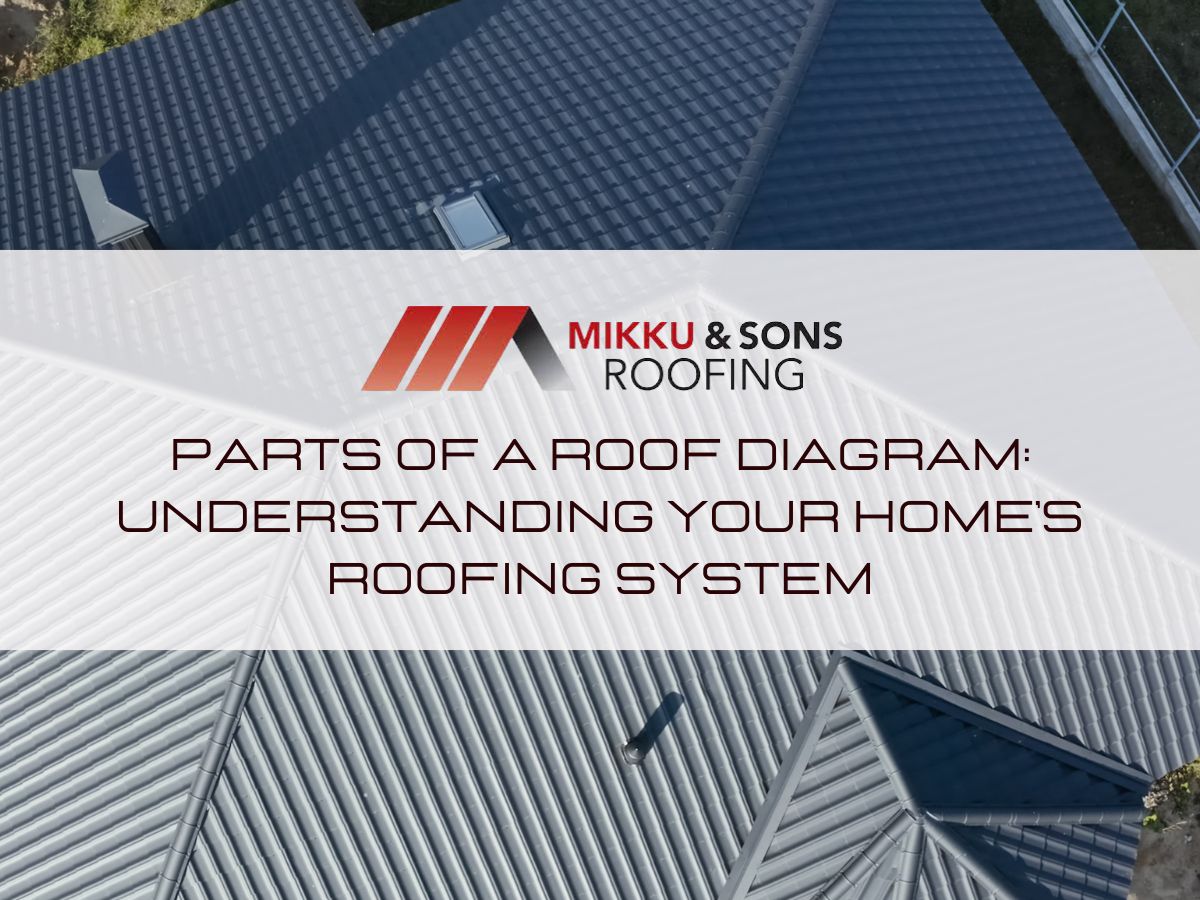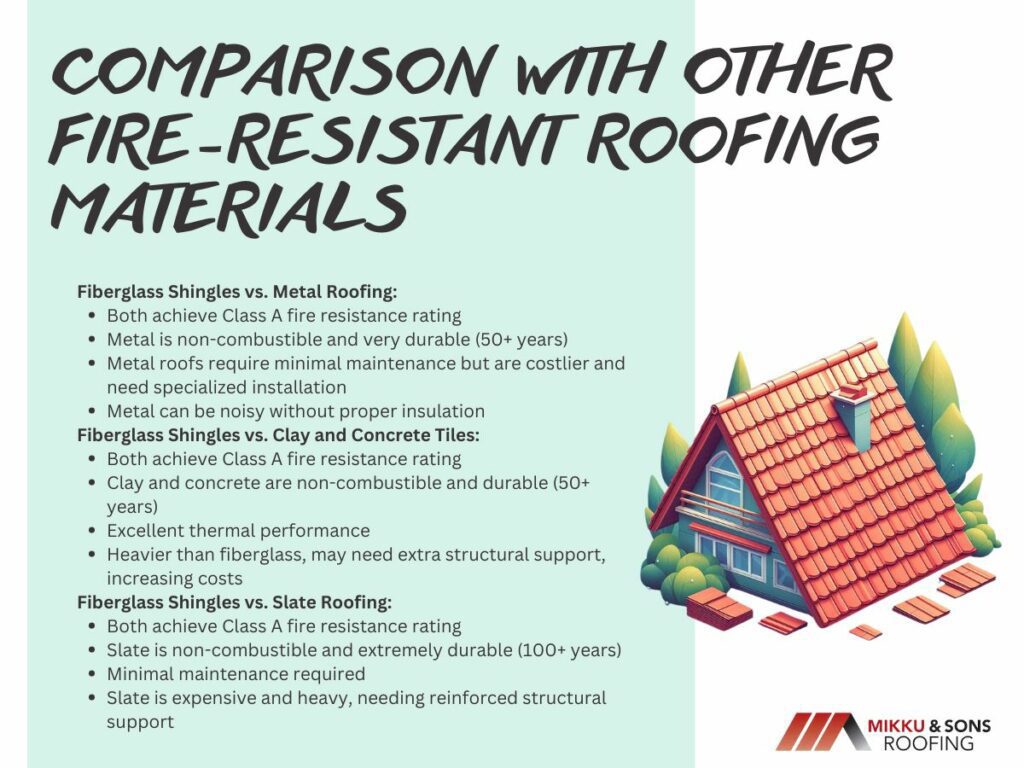

When it comes to protecting your home, the choice of roofing material is crucial, especially in areas prone to wildfires or high temperatures. Fire-resistant roofing can significantly reduce the risk of fire spreading, providing an extra layer of security for your property and peace of mind for you.
Among the various roofing materials available, fiberglass shingles stand out for their excellent fire resistance properties. Fiberglass shingles are a popular choice for many homeowners due to their durability, aesthetic appeal, and affordability.
However, their fire resistance is a standout feature that makes them particularly valuable. Let's look at the fire resistance of fiberglass shingles.
Fiberglass shingles are a type of asphalt shingle that incorporates a fiberglass mat as the core of the shingle. This construction differs from traditional organic mat asphalt shingles, where the core is made of paper or wood fibers.
The fiberglass mat is coated with asphalt, and then ceramic granules are embedded on the surface to provide additional protection and aesthetic appeal. This design not only makes fiberglass shingles lightweight but also enhances their fire-resistant properties.
The popularity of fiberglass shingles has grown significantly due to their combination of durability, cost-effectiveness, and fire resistance. They are an ideal choice for homeowners looking for a reliable roofing material that can withstand various weather conditions while also providing a high level of protection against fire.
Fiberglass shingles are composed of several layers, each contributing to their overall performance.
The manufacturing process of fiberglass shingles ensures that they are less prone to warping and curling compared to traditional organic shingles. The fiberglass core is more stable and less susceptible to moisture absorption, which can be a common issue with other types of shingles.
When compared to other roofing materials, fiberglass shingles offer a unique blend of advantages.
Fire resistance ratings are a crucial factor to consider when selecting roofing materials, especially in areas susceptible to wildfires or where building codes enforce strict fire safety regulations. Fire resistance ratings classify materials based on their ability to withstand fire and prevent its spread.
These ratings are determined through rigorous testing procedures established by organizations such as Underwriters Laboratories (UL) and ASTM International. Understanding the fire resistance rating of fiberglass shingles can help homeowners make informed decisions about their roofing needs.
Class A fire resistance is the highest rating a roofing material can achieve. It indicates that the material can withstand severe fire exposure without igniting or contributing to the spread of flames. To attain a Class A rating, roofing materials must undergo a series of stringent tests, including burning brand tests, flame spread tests, and intermittent flame tests.
Fiberglass shingles often achieve a Class A fire resistance rating due to their composition. The fiberglass mat at the core is inherently non-combustible, and the asphalt coating, combined with ceramic granules, provides additional protection against fire.
This makes fiberglass shingles an excellent choice for homeowners looking to maximize their fire protection. A Class A rating not only enhances the safety of the home but can also lead to lower insurance premiums, as many insurance companies offer discounts for homes with high fire-resistant roofing materials.
While Class A is the highest fire resistance rating, Class B and Class C ratings also provide varying degrees of fire protection. Class B-rated materials can withstand moderate exposure to fire and are often used in areas with a lower risk of wildfires.
These materials must pass similar tests to Class A materials but are not required to perform as well under extreme conditions. Class C-rated materials offer basic fire protection and can withstand light exposure to fire.
They are typically used in regions with minimal fire risk or in temporary structures.
Fiberglass shingles offer numerous advantages in fire protection, making them a preferred choice for homeowners and builders looking for reliable and safe roofing materials. The combination of a non-combustible fiberglass core and protective asphalt coating, along with ceramic granules, provides a formidable defense against fire.

One of the most significant advantages of fiberglass shingles is their high fire resistance. Unlike organic mat shingles, which can easily ignite and contribute to the spread of fire, fiberglass shingles have a non-combustible core that does not burn.
This inherent fire resistance is further enhanced by the asphalt coating and ceramic granules that form a protective barrier against flames and heat. As a result, fiberglass shingles can achieve a Class A fire resistance rating, the highest possible rating for roofing materials.
This makes them an excellent choice for homes in areas prone to wildfires or regions with strict fire safety regulations.
Installing fiberglass shingles can significantly enhance the safety of a home by providing robust protection against fire. In the event of a fire, the fire-resistant properties of fiberglass shingles can prevent the roof from igniting and help contain the fire, giving occupants more time to evacuate and emergency services more time to respond.
This added layer of protection can be crucial in saving lives and minimizing property damage. Homeowners can also enjoy peace of mind knowing that their roof is made of a material specifically designed to withstand fire exposure.
Fiberglass shingles are not only fire-resistant but also highly durable and long-lasting. Their resistance to fire does not compromise their overall performance in other areas. Fiberglass shingles are known for their ability to withstand various environmental conditions, including strong winds, heavy rain, and extreme temperatures.
This durability translates to a longer lifespan for the roofing material, reducing the need for frequent replacements and maintenance. Additionally, the fire-resistant properties of fiberglass shingles remain effective throughout their lifespan, ensuring continuous protection for the home.
While the initial cost of fiberglass shingles may be comparable to other roofing materials, their long-term cost-effectiveness is a significant advantage. The durability and low maintenance requirements of fiberglass shingles mean that homeowners can save money on repairs and replacements over time.
Moreover, the high fire resistance of fiberglass shingles can lead to lower insurance premiums. Many insurance companies offer discounts for homes with fire-resistant roofing materials, recognizing the reduced risk of fire-related claims. This cost-saving benefit adds to the overall value of choosing fiberglass shingles.
Fiberglass shingles also offer environmental benefits, contributing to their appeal as a roofing material. They are often made from recycled materials, and their long lifespan reduces the frequency of replacements, leading to less waste.
Additionally, the energy-efficient properties of fiberglass shingles can help reduce heating and cooling costs, making homes more environmentally friendly. By choosing fiberglass shingles, homeowners can contribute to sustainability efforts while also enhancing the fire protection of their property.
When choosing roofing materials, fire resistance is a critical factor, especially in areas prone to wildfires or where building codes require fire-resistant construction. While fiberglass shingles offer excellent fire protection, it’s essential to compare them with other fire-resistant roofing materials to make an informed decision.

Metal roofing is another highly fire-resistant option, often achieving a Class A fire resistance rating similar to fiberglass shingles. Metal roofs are non-combustible, meaning they do not ignite or contribute to the spread of fire.
This makes them an excellent choice for fire-prone areas. Additionally, metal roofing is extremely durable, with a lifespan that can exceed 50 years, and it requires minimal maintenance.
However, metal roofing can be more expensive to install than fiberglass shingles, and the installation process is more complex, often requiring specialized labor. Metal roofs can also be noisy during rain or hailstorms unless proper insulation is used.
Clay and concrete tiles are renowned for their fire-resistant properties, often achieving Class A ratings. These materials are non-combustible and provide a robust barrier against fire.
They are also highly durable and can last up to 50 years or more with proper maintenance. Clay and concrete tiles offer excellent thermal performance, helping to keep homes cooler in hot climates.
The primary drawback of clay and concrete tiles is their weight. These materials are significantly heavier than fiberglass shingles, which can necessitate additional structural support and increase installation costs.
Slate roofing is another top-tier fire-resistant material, also achieving a Class A rating. Slate is a natural stone that is non-combustible and offers exceptional fire protection.
It is also one of the most durable roofing materials available, with a lifespan that can exceed 100 years. Slate roofing is highly resistant to weathering and requires minimal maintenance.
However, slate roofing is one of the most expensive options, both in terms of material costs and installation. The weight of slate tiles is also a significant consideration, often requiring reinforced structural support.
Fiberglass shingles offer an excellent combination of fire resistance, durability, and aesthetic appeal, making them a top choice for homeowners looking to enhance their home's safety. With a Class A fire rating, fiberglass shingles provide a high level of protection, reducing the risk of fire spread and potentially lowering insurance costs.
Choosing fire-resistant roofing materials is a critical step in safeguarding your home from the increasing threat of wildfires and other fire hazards. By choosing materials with high fire ratings you can significantly reduce the risk of fire spreading to your property.
By prioritizing fire safety in your home improvement projects, you are taking a proactive approach to protecting your family and property. As you consider your next roofing project, remember that choosing fire-resistant materials is not just about compliance with safety standards; it's about ensuring the safety of your home for years to come.
